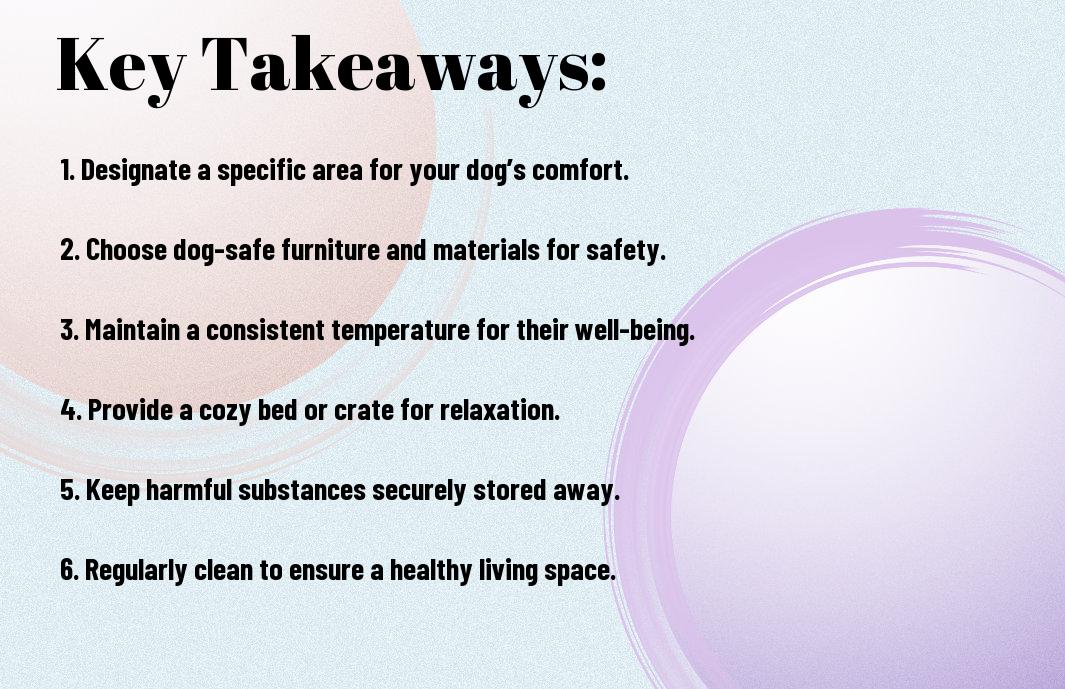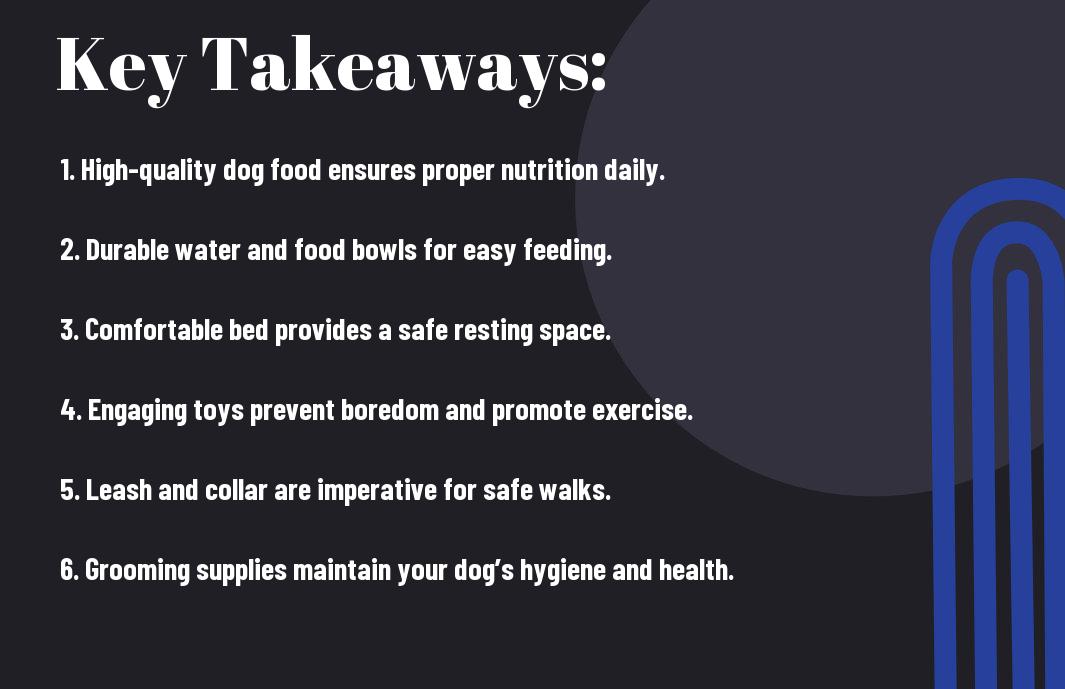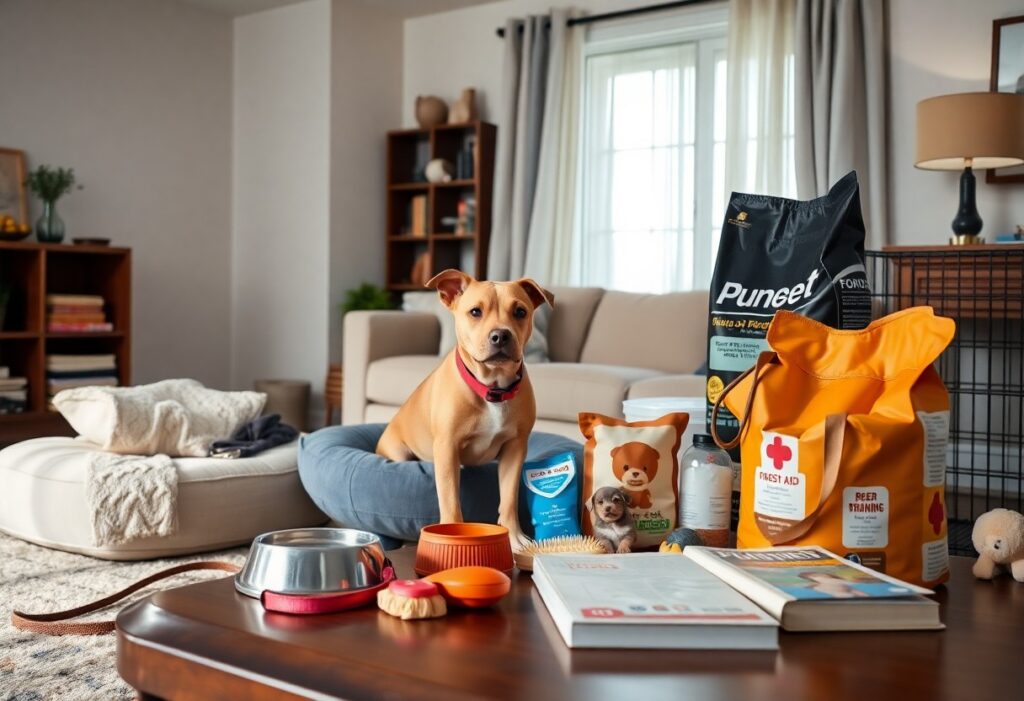Dogs thrive in environments that prioritize their safety and comfort, allowing them to flourish as happy and healthy companions. By making thoughtful adjustments to your home, you can create a space where your dog feels secure and content. From choosing the right supplies to maintaining a clean and safe environment, there are several key factors to consider. In this blog post, you will discover practical tips and insights to transform your living space into a haven for your furry friend.

Understanding Your Dog’s Needs
The needs of your dog encompass various aspects of their life, including their physical environment, behavioral expectations, and social interactions. Understanding these needs helps you to provide a safe and comfortable atmosphere where your dog can thrive. When you take the time to meet your dog’s individual requirements, you build a strong bond with them while promoting their overall wellbeing.
Importance of Physical Space
For dogs, having an appropriate physical space is important. Your home environment should provide enough room for your dog to move freely, play, and relax. Consider creating designated areas for activities such as eating, sleeping, and playing. This not only helps to prevent accidents but also gives your dog a sense of security and stability within your home.
Additionally, the physical space should be safe from hazards. Remove any choking hazards, toxic plants, and small objects that your dog might swallow. Providing a cozy, clean sleeping area enables your dog to feel secure and comfortable. By ensuring that their physical space is tailored to their needs, you contribute significantly to their happiness and peace of mind.
The Role of Routine in a Dog’s Life
By establishing a consistent daily routine for your dog, you foster a sense of stability and predictability that can greatly reduce anxiety. Dogs thrive on routine as it helps them understand what to expect throughout the day—whether it’s their feeding schedule, walk times, or play periods. When you prioritize consistency, your dog becomes more confident and comfortable in their environment.
Routine helps keep your dog mentally engaged and focused, which can minimize negative behaviors stemming from boredom or excess energy. A structured day filled with regular exercise, feeding, and training sessions not only meets your dog’s physical needs but also nurtures their mental health. Establishing healthy habits in your dog’s daily life will create a more harmonious living situation for both you and your furry companion.
Recognizing Behavioral Cues
Space is often an overlooked aspect of recognizing your dog’s needs. Dogs communicate their feelings and needs through body language and behaviors, so paying close attention to these cues is important. For instance, if your dog is pacing, whining, or showing signs of stress, they may be indicating that they need more space or a change in their environment. Learning to interpret these signals correctly can enhance the bond you share with your dog and support their emotional wellbeing.
For instance, a dog constantly scratching at the door or barking may be trying to signal that they need to go outside for exercise or a bathroom break. Alternatively, if your dog is hiding or avoiding interaction, they might be overwhelmed or anxious in their current environment. By being attentive to these behavioral cues, you can address your dog’s needs more effectively, leading to a healthier and happier life for both of you.

Safe Outdoor Environment
Assuming that you want to provide your dog with a secure and enjoyable outdoor space, it is imperative to evaluate the options available to you. Outdoor environments can greatly enhance your dog’s quality of life by allowing them to explore, play, and exercise in a safe setting. However, ensuring that these spaces are safe for your furry friend requires attention to detail and thoughtful planning.
Fenced In Spaces: Pros and Cons
An effective way to create a safe outdoor environment is by establishing a fenced-in area. This not only gives your dog the freedom to roam but also minimizes the risk of them escaping or encountering hazards. However, there are various pros and cons to consider when deciding whether a fenced-in space is right for you and your pet.
Pros and Cons
| Pros | Cons |
|---|---|
| Provides a secure area for your dog to play freely | Can be costly to install and maintain |
| Reduces the risk of escape and injury | The dog may feel confined and anxious in a limited space |
| Protects from unknown animals and hazards | Requires regular checks for wear and damage |
| Allows for socialization with other pets through proper introduction | May limit their social interactions with other dogs outside the fence |
| Creates a defined area for designated potty training | Pests or wildlife can occasionally breach the area if not properly maintained |
Dog Parks: Safety Tips
One of the popular options for providing your dog with a safe outdoor environment is visiting a local dog park. These parks can offer your dog the opportunity to socialize and exercise, but you must keep your pet’s safety in mind. To ensure a fun and safe experience, adhere to a few important safety tips.
- Always keep your dog leashed until you are in the designated off-leash area.
- Observe your dog’s behavior and be mindful of other dogs’ body language.
- Make sure your dog is up to date on vaccinations and is free of parasites.
- Bring fresh water and a portable bowl for your dog to stay hydrated.
This will not only help keep your dog safe but also contribute to a pleasant experience for everyone involved.
In fact, employing additional precautions can further enhance your dog’s safety at the park. When you visit, it is advisable to take note of your surroundings and any potential hazards. You can also bring treats to reward good behavior and help build positive associations with the park environment.
- Monitor playtime and intervene if play becomes too rough.
- Avoid bringing toys that can lead to possessiveness among dogs.
- Keep an eye on your dog’s energy level to prevent exhaustion.
This attention to detail can foster a safe and enjoyable atmosphere for your dog and provide peace of mind for you as their owner.
Hazards to Avoid in Your Yard
Across your backyard, various potential hazards might put your dog at risk. Understanding which dangers to watch for is key to creating a safe space. Common threats include toxic plants, sharp objects, and unsecured gates. It’s vital to canine-proof your yard to ensure that it remains a haven for your pet.
Hence, it’s imperative to routinely inspect your outdoor space for any hazards your dog may encounter. Removing hazards like broken glass, exposed nails, or toxic landscaping plants aids in providing a more secure environment for your dog. Furthermore, keep any chemicals or harmful substances, like fertilizers and pesticides, stored safely out of reach.

Creating a Comfortable Indoor Space
Your dog’s indoor space should be a sanctuary that enhances their comfort and well-being. Ensuring this space is inviting and relaxing can significantly impact their overall mood and behavior. Start by evaluating your home for areas where your dog spends the most time and tailor those spaces to cater to their needs. This can involve selecting specific areas for sleeping, playing, and simply chilling out, to create a dynamic and functional living environment.
Choosing the Right Sleeping Area
Space is vital when picking a sleeping area for your dog. Consider their size, sleeping habits, and personal preferences. A large dog may require a spacious bed or mat, while a small dog might be content in a cozy nook. Observe where your dog likes to nap and ensure that their sleeping area is positioned in a quiet, low-traffic part of your home. A comfortable bed made with soft materials will encourage relaxation and promote quality sleep.
You should also consider the specific needs of your dog based on their breed, age, and health. An orthopedic bed might be ideal for older dogs with joint issues, while a versatile crate or a soft blanket could work well for puppies or those who like to burrow. Ultimately, creating a designated sleeping area that feels safe and warm will help your dog recharge and feel more secure in their environment.
Temperature Control in Your Home
Among the various factors that contribute to your dog’s comfort indoors, temperature control plays a significant role. Dogs can be sensitive to extreme temperatures, so ensuring that your home remains a comfortable climate will help them thrive. During hotter months, make sure they have access to shaded areas and plenty of fresh water. On cooler days, provide soft blankets or heated beds for them to curl up in.
Factors Affecting Indoor Temperature
| Factor | Impact on Comfort |
|---|---|
| Heating/Cooling Systems | Maintain a consistent temperature throughout your home. |
| Drafts | Can cause discomfort; ensure windows and doors are properly sealed. |
| Humidity Levels | Can affect how warm or cool a space feels; use a dehumidifier or humidifier as needed. |
This attention to temperature not only ensures your dog’s well-being but also helps to prevent any health issues that may arise from uncomfortable living conditions. Simple adjustments, such as using window treatments to block out heat in the summer, can make a big difference in your dog’s comfort level. Always seek to create an optimal indoor climate by considering both the temperature and humidity levels in your home.
Analyzing Dog-Friendly Furniture
On your journey to create a cozy indoor environment for your dog, it is vital to analyze the furniture within your space. Choose pieces that are durable, easy to clean, and designed with safety in mind. Avoid furniture with sharp edges or easily damaged materials, as these can pose risks to both your dog and the items in your home. Instead, opt for pet-friendly materials that can withstand your dog’s energy while remaining pleasant to touch.
Incorporating dog-friendly furniture into your home can also enhance your dog’s living experience. Look for items like washable coverings, sturdy fabric, and chew-resistant materials that can tolerate wear. Additionally, investing in stylish dog furniture that complements your home decor will make your space feel inviting while still accommodating your furry friend.
Understanding the combination of dog-friendly furniture and complementary décor is vital for creating a comfortable living environment. Blending these choices can help foster a sense of integration between your dog’s needs and your home’s aesthetic, allowing both you and your dog to enjoy a welcoming atmosphere.
Nutrition and Health Considerations
For your dog to thrive in a safe and comfortable living environment, prioritizing their nutrition and health is imperative. Proper nutrition is not only imperative for your dog’s growth and energy levels, but it also plays a role in keeping their immune system strong and aiding their overall well-being.
Providing Proper Nutrition
Around the clock, your dog’s nutritional needs will change based on their age, breed, weight, and activity level. It is imperative to choose high-quality dog food that meets the standards set by organizations like the Association of American Feed Control Officials (AAFCO). Incorporating a balanced diet that includes proteins, carbohydrates, fats, vitamins, and minerals will support your furry friend’s health. You might also consider consulting with a veterinarian or a pet nutritionist to determine the best diet plan tailored specifically for your dog.
Additionally, be cautious about the treats you offer. While it’s tempting to share your snacks, many human foods can be harmful to dogs. Instead, opt for healthy dog treats that are formulated to be nutritious while also being tempting enough for them to enjoy. A well-balanced diet will keep your dog happy, energized, and ready to accompany you on various adventures.
Regular Vet Checkups
Behind every healthy dog is a committed owner who ensures regular veterinary checkups. Scheduling annual visits to your veterinarian not only helps in early detection of potential health issues but also provides an opportunity for vaccinations and preventative care. These visits can include assessments of your dog’s weight, dental health, and vaccinations that protect against common diseases.
Further, keep in mind that some dogs may require more frequent visits due to health issues or certain life stages. Puppies, for example, often need more regular checkups to monitor their growth and vaccination schedule, while senior dogs may require semi-annual visits to manage any age-related conditions. Keeping a record of your dog’s health history will also aid your vet in understanding their unique needs over time.
Dental Health Essentials
Any dog owner knows that dental care is an often-overlooked aspect of canine health. Regular dental hygiene can prevent the buildup of plaque and tartar, which can lead to more severe health issues such as gum disease and tooth loss. Investing in dental chews, toys, and even professional cleanings will help maintain your dog’s oral health, ensuring they remain comfortable and pain-free.
In addition to promoting good breath and taking care of their smiles, proper dental health can play an important role in your dog’s overall well-being. Oral bacteria can enter your dog’s bloodstream, potentially affecting vital organs such as the heart and kidneys. By placing emphasis on dental health, you’re not only improving their quality of life but also contributing to their longevity.
Mental Stimulation and Enrichment
Unlike physical exercise, mental stimulation is often overlooked when it comes to creating a safe and comfortable living environment for your dog. Mental enrichment is just as important as physical activity because it helps prevent boredom, promotes good behavior, and facilitates overall well-being. Providing your dog with various activities that engage their minds is crucial for their happiness and health. Integrating elements of mental stimulation into your dog’s daily routine will not only keep them entertained but also help build a stronger bond between you and your furry friend.
Interactive Toys and Games
Along with regular walks and playtime, you should consider incorporating interactive toys and games into your dog’s routine. These toys are designed to challenge your dog’s problem-solving abilities and keep them engaged for longer periods. Puzzle toys that conceal treats or toys that require your dog to perform specific actions to receive a reward are fantastic options. By providing a variety of interactive toys, you ensure that your dog stays mentally stimulated and less prone to destructive behaviors caused by boredom.
Training and Obedience
By engaging in consistent training and obedience exercises, you not only improve your dog’s behavior but also provide them with vital mental stimulation. Training sessions can be fun and rewarding for both you and your dog. Teaching new commands or tricks challenges your dog’s intellect and encourages them to think critically. Use positive reinforcement methods, such as treats or praise, to motivate your dog and make learning an enjoyable experience.
Indeed, obedience training is a powerful form of mental enrichment and can significantly enhance your dog’s focus and concentration. Regular training sessions encourage your dog to engage their brains and foster a sense of purpose. Additionally, the bond created through training helps establish trust and communication between you, further enhancing your dog’s overall comfort and security in your home.
Socialization with Other Dogs
Toys and activities that promote socialization with other dogs are crucial for your dog’s mental health as well. Introducing your dog to a variety of social settings, such as dog parks or supervised playdates, helps them refine their social skills and learn how to communicate effectively with other canines. These interactions can challenge your dog mentally, allowing them to engage in play that teaches them about boundaries and appropriate behavior.
At these social gatherings, you can witness your dog explore new dynamics while building confidence in their interactions. It’s vital to ensure that these experiences are positive and stress-free, as this will condition your dog to appreciate social engagements in the future. Just like training, these social experiences play a significant role in your dog’s development, enriching their lives and contributing to their overall well-being.
Managing Stress and Anxiety
After bringing your dog into your home, it’s crucial to create an environment where they feel safe and comfortable to eliminate stress and anxiety. Understanding and addressing these feelings can significantly improve your dog’s overall quality of life. Just like humans, dogs experience stress and anxiety due to various factors, including loud noises, being left alone, or changes in their environment. Effective management involves recognizing these stressors and implementing strategies to help your dog cope.
Identifying Triggers
At the start of addressing your dog’s stress and anxiety, you need to identify what triggers these feelings. Observing your dog’s behavior in different situations can provide valuable insights. For instance, does your dog become anxious during thunderstorms, or do they show signs of distress when you leave the house? These reactions can manifest in numerous ways, such as excessive barking, hiding, or destructive behavior. Keeping a journal of your dog’s behavior will help you pinpoint specific stressors and patterns.
At home, try to create a calm atmosphere by minimizing exposure to known triggers. You might notice that particular sounds, like sirens or fireworks, cause anxiety. If possible, you can isolate your dog from these stimuli by providing a safe haven, such as a cozy crate or a specific room where they feel most secure. Understanding and acknowledging what makes your dog anxious is the first step toward helping them feel more at ease.
Soothing Techniques: Music and Visualization
Below are some soothing techniques you can utilize to help calm your dog during stressful situations. One effective strategy is to play calming music designed specifically for dogs. Research has shown that certain melodies can help reduce anxiety levels, creating a relaxing environment. Pairing this with visualization techniques, where you create a mental picture of a peaceful, happy place, can further enhance your dog’s comfort during challenging moments.
Below, it’s important to note that consistency is critical when applying these soothing techniques. Regularly integrating calming music into your dog’s routine can condition them to associate it with tranquility. Meanwhile, visualization can be practiced together with your dog during relaxation times, reinforcing a peaceful state of mind. Over time, these techniques may help your dog become more resilient in facing stressful situations.
The Benefits of Calming Products
Anxiety can manifest in various ways in your dog’s daily life, and finding appropriate solutions is crucial. Calming products, such as anxiety wraps, pheromone diffusers, and calming treats, can provide additional support. These items are designed to comfort your dog and help manage their stress, making it easier for them to navigate their environment without feeling overwhelmed. By integrating these products into your dog’s routine, you can create a nurturing atmosphere that fosters stability and peace.
Due to their effectiveness, calming products can give you an additional tool in your arsenal for managing your dog’s stress and anxiety. Products like anxiety wraps apply gentle pressure, simulating a hug that can soothe your dog. Meanwhile, calming pheromones work by mimicking the natural scents that promote a sense of safety and comfort. Utilizing these methods in conjunction with your understanding of your dog’s triggers can significantly improve their well-being and help them thrive in their living environment.
Summing up
As a reminder, creating a safe and comfortable living environment for your dog involves thoughtful attention to both their physical needs and emotional well-being. Start by ensuring your home is free from hazardous items and toxic plants, and provide a designated space where your dog can retreat and find comfort. This includes using pet-friendly furniture and investing in comfortable bedding that fosters a sense of security for your furry companion. Regularly assess your surroundings for potential dangers and make necessary adjustments to keep your dog safe and happy.
Additionally, consider the importance of socialization, mental stimulation, and physical activity in your dog’s life. Incorporating playtime, training sessions, and regular walks not only strengthens your bond but also keeps your dog mentally engaged and physically fit. By integrating these factors into your daily routine, you can create an environment that not only supports your dog’s health but also enriches their overall quality of life. A harmonious home will serve as a sanctuary for your dog, allowing them to thrive and be a happy member of your family.
Q: What are the crucial elements to consider when creating a safe living space for my dog?
A: To ensure a safe living environment for your dog, focus on removing potential hazards such as chemicals, small objects that could be swallowed, and sharp items. It’s also important to secure electrical cords and sturdy furniture that won’t tip over. Provide designated areas for your dog to eat, sleep, and play, using comfortable bedding and toys suitable for their size and chewing habits. Make sure that all doors and windows are secured to prevent escapes, and consider safety gates to restrict access to certain areas of the home.
Q: How can I make my dog’s space more comfortable and enjoyable?
A: Comfort for your dog can be achieved by providing a cozy bed in a quiet area where they can retreat when needed. Ensure that the temperature in your home is appropriate for your dog, avoiding extreme heat or cold. Incorporate soft lighting and eliminate loud noises to promote a peaceful atmosphere. Additionally, personalize their space with toys, blankets, and even interactive puzzles to keep their mind engaged and provide a sense of security.
Q: What steps should I take to maintain a clean and hygienic environment for my dog?
A: Maintaining cleanliness is vital for your dog’s health. Regularly wash their bedding and toys to minimize odors and bacteria. Establish a routine for grooming, including brushing and bathing, to remove loose fur and dirt. Create a designated area for eating and drinking, and clean up spills promptly. Additionally, make sure to regularly clean up after your dog’s bathroom habits to keep both your home and yard tidy while preventing any health risks.










